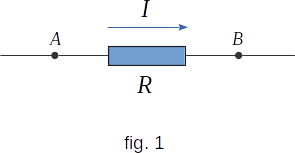From the Direct electric current
92. Ohm's law for the circuit section. Resistance
It has already been mentioned that the current force in a conductor is determined by the potential difference at the ends of the conductor. For each conductor there is a dependence of the electric current force on the applied potential differenc
\( I \,= f(\Delta{V}) \)
This dependence is called a current-voltage characteristic of the conductor. Its establishment plays a primary role in the consideration of phenomena associated with the passage of electric current.
The simplest view, as experience shows (see Physics Books One), has a current-voltage characteristic of metallic conductors and electrolytes.

Figure 1 shows a section of the \(AB\) conductor. Let us denote through \(V_a\) the potential of point \(A\), and through \(V_b\) the potential of point \(B\). If \(V_a>V_b\), the current flows in the direction from \(A\) to \(B\) because the electric field inside the conductor is directed in this direction. The potential difference at the ends of the conductor, or voltage, is
\( \Delta{V_{ab}} \,= \,V_a-V_b \)
For metals and electrolytes, the current force is proportional to the applied voltage
\( I \,= \,\Lambda(V_a-V_b) \,= \,\Lambda\Delta{V_{ab}} \)
This dependence is called the law Ohm's for the circuit section. Here \(\Lambda\) (Lambda) is the coefficient of proportionality, not depending on voltage. It is called electrical conductivity of the conductor. Value, inverse to electrical conductivity of the conductor,
\( R \,= \,\frac{1}{\Lambda} \)
is called electrical resistance or simply resistance.
Usually the current force in Ohm's law is expressed through \(R,\) not through \(\Lambda\)
\( I \,= \,\frac{\Delta{V_{ab}}}{R} \) (9-4)
Ohm's law defines a new electrical characteristic of a conductor, resistance (or electrical conductivity). This value depends on the material of the conductor, its geometric dimensions and shape. For cylindrical conductors, this dependence is very simple. If \(l\) - length of the conductor, \(A\) - area of cross-section, then
\( R \,= \,\rho\frac{l}{A} \)
Here \(\rho\, \) is the value, depending on the type of substance and its state (temperature in the first order). The value of \(\rho \,\) is called the specific resistance of the conductor. The value inverse to the specific resistance of the conductor,
\( \lambda \,= \,\frac{1}{\rho} \)
is called specific electrical conductivity. The specific resistance in SI units is equal to the resistance of a substance cube with an edge of \(1 \,m\).
The unit of resistance of the conductor is set using equation \((9-4)\) and is called Ohm. A conductor has a resistance of \(1 \,Ohm\,\) if, at a potential difference of \(1\,V\), an electric current of \(1 \,A\) flows through it.
The unit of specific resistance is \(1 \,Ohm \cdot m\). For metals, the specific resistance is small. For example, for copper \(\rho \,= \,1.78 \cdot \,10^{-8} \,Ohm \cdot m.\) Dielectrics, such as porcelain, also have conductivity. But their specific resistance is so enormous that this conductivity can be practically neglected. For porcelain, \(\rho \,= \,10^{13} \,Ohm \cdot m.\)